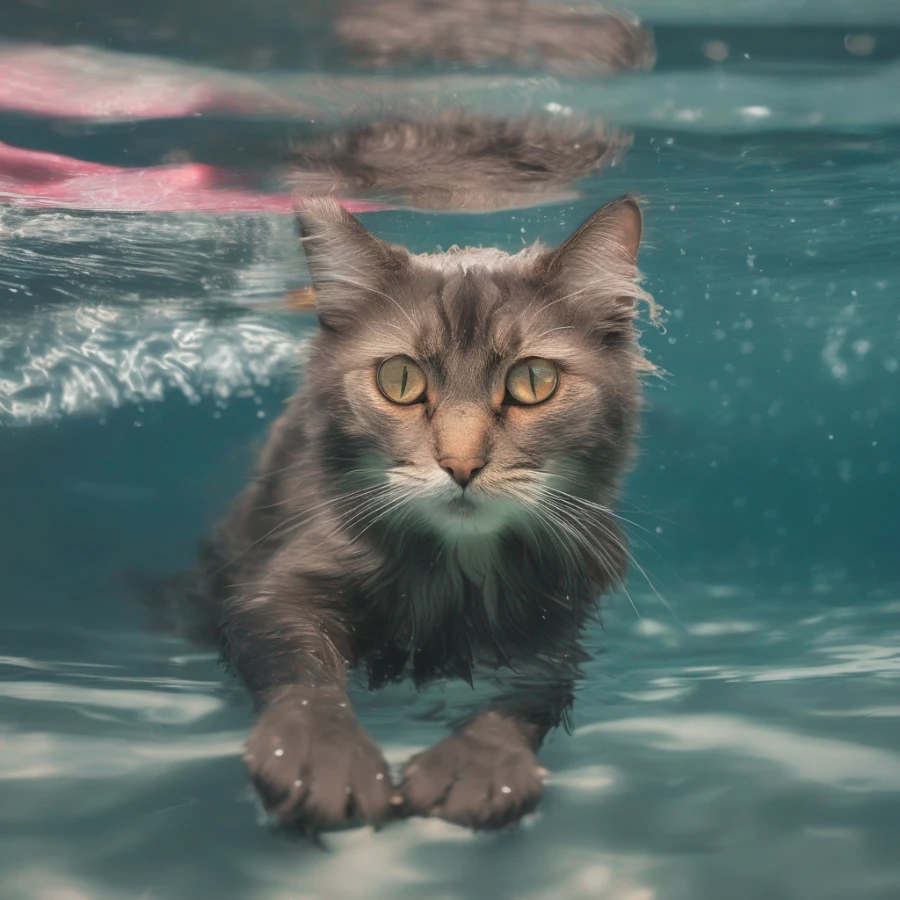Arteriovenous fistula in Cats: Diagnosis, Causes, Symptoms & Treatment
Arteriovenous fistula in cats is an abnormal connection between an artery and a vein. It disrupts normal blood flow and can occur due to congenital defects, trauma, or surgical procedures.

What is an Arteriovenous fistula
Arteriovenous fistula in cats is a rare condition characterized by an abnormal connection between an artery and a vein. Normally, arteries carry oxygenated blood away from the heart to various parts of the body, while veins carry deoxygenated blood back to the heart. In an arteriovenous fistula, there is an abnormal direct communication between an artery and a vein, bypassing the capillary network.
Arteriovenous fistulas can occur in cats due to various factors. Some cats are born with congenital defects that predispose them to develop these abnormal connections. Trauma, such as injuries or bite wounds, can also lead to the formation of arteriovenous fistulas. Additionally, certain surgical procedures, such as vascular surgery or catheterization, can inadvertently create these abnormal connections.
The presence of an arteriovenous fistula disrupts the normal flow of blood. Blood flows directly from the artery into the vein, bypassing the capillaries, which are responsible for oxygen and nutrient exchange. This abnormal blood flow can lead to various complications. It can cause the affected vein to dilate and become enlarged, leading to swelling and potential rupture. It can also result in inadequate oxygenation of tissues, leading to tissue damage or dysfunction.
Diagnosing arteriovenous fistula in cats usually involves a thorough physical examination, evaluation of clinical signs, and imaging tests such as ultrasound, angiography, or computed tomography (CT) scans. These tests help visualize the abnormal connection between the artery and vein and assess its size and location.
Treatment options for arteriovenous fistula in cats depend on various factors, including the size and location of the abnormal connection, the presence of symptoms, and the overall health of the cat. In some cases, surgical correction may be performed to close off the abnormal connection and restore normal blood flow. Another treatment option is embolization, where a material is introduced into the abnormal connection to block the flow of blood. This is often done using minimally invasive techniques.
Proper management and follow-up care are essential for cats with arteriovenous fistulas. It is important to monitor for any signs of complications or recurrence. Pain management, wound care, and monitoring of blood flow and tissue oxygenation may be necessary during the recovery period.
Overall, arteriovenous fistula in cats is a complex condition that requires prompt diagnosis and appropriate treatment. With timely intervention and proper management, affected cats can experience improved quality of life and reduced risk of complications.
Cat Arteriovenous fistula Symptoms
The symptoms of arteriovenous fistula in cats can vary depending on the location and severity of the abnormal connection. Here are some common symptoms associated with arteriovenous fistula in cats:
Swelling: Swelling or a bulging appearance may be noticeable at the site where the abnormal connection is present. This is often due to the increased blood flow and dilation of the affected vein.
Bruising: The presence of bruises or discoloration around the affected area may occur due to the increased blood flow and potential leakage from the abnormal connection.
Pulse or thrill: A pulse or vibratory sensation may be felt over the area of the arteriovenous fistula. This is due to the direct communication between the artery and vein, causing an abnormal blood flow pattern.
Poor wound healing: Cats with arteriovenous fistula may experience delayed or impaired wound healing, especially if the abnormal connection is in the vicinity of a surgical incision or injury site.
Pain or discomfort: Cats may exhibit signs of pain or discomfort, such as lameness, reluctance to move, or vocalization, especially if the arteriovenous fistula causes pressure on surrounding tissues or nerves.
It is important to note that not all cats with arteriovenous fistula will exhibit noticeable symptoms. Some cases may be asymptomatic, especially if the abnormal connection is small or located in a less critical area. Therefore, a proper diagnosis by a veterinarian is crucial to confirm the presence of arteriovenous fistula and determine the appropriate treatment.
Causes of Arteriovenous fistula in Cats: Understanding the Triggers of Feline Health Issues
Arteriovenous fistula in cats is typically caused by a congenital defect, meaning it is present from birth. The exact cause of the abnormal connection between an artery and a vein is not fully understood, but it is believed to be due to developmental abnormalities during the formation of blood vessels in the early stages of fetal development.
While the precise factors contributing to arteriovenous fistula formation are unknown, genetic predisposition may play a role. Certain breeds, such as the Persian and Himalayan, have been reported to have a higher incidence of arteriovenous fistula.
In some cases, arteriovenous fistula can also occur as a result of trauma or injury to the blood vessels. This can happen when a cat experiences significant trauma, such as a penetrating wound or a fracture that disrupts the blood vessels.
It's important to note that arteriovenous fistulas in cats are relatively rare compared to other vascular abnormalities. Most cases are congenital in nature, and the exact cause may vary from one cat to another. Proper diagnosis and evaluation by a veterinarian are essential in understanding the underlying cause of arteriovenous fistula in individual cats.
Diagnosis of Arteriovenous fistula in Cats: Identifying Feline Health Conditions
The diagnosis of arteriovenous fistula in cats typically involves a combination of physical examination, imaging tests, and sometimes additional diagnostic procedures. Here are some common diagnostic methods used to identify arteriovenous fistula in cats:
Physical Examination: The veterinarian will perform a thorough physical examination of the cat, looking for any visible signs of abnormal blood vessels or swelling in the affected area.
Doppler Ultrasound: Doppler ultrasound is a non-invasive imaging technique that uses sound waves to evaluate blood flow. It can help identify the abnormal blood vessels and assess the direction and velocity of blood flow within the fistula.
Contrast Radiography: Contrast radiography involves injecting a contrast dye into the blood vessels to visualize their structure and identify any abnormal connections. X-rays or fluoroscopy may be used to capture images as the dye flows through the vessels.
Angiography: Angiography is a more invasive diagnostic procedure that involves the injection of a contrast dye directly into the blood vessels. X-ray images are then taken to visualize the blood vessels and identify the location and extent of the arteriovenous fistula.
Magnetic Resonance Imaging (MRI) or Computed Tomography (CT) Scan: These imaging techniques can provide detailed images of the blood vessels and surrounding tissues, helping to identify the presence and characteristics of an arteriovenous fistula.
It's important to consult with a veterinarian who is experienced in diagnosing and treating vascular abnormalities in cats. They will be able to recommend the most appropriate diagnostic tests based on the cat's specific symptoms and medical history.
Treatment of Arteriovenous fistula in Cats: Managing Feline Health Conditions
The treatment of arteriovenous fistula in cats depends on the severity of the condition and the specific circumstances of the individual cat. Here are some common treatment options for arteriovenous fistula in cats:
Conservative Management: In some cases, if the arteriovenous fistula is small and not causing significant symptoms or complications, a conservative approach may be taken. This involves monitoring the cat closely and managing any associated symptoms, such as pain or swelling, with appropriate medications.
Surgical Intervention: Surgical correction is often the primary treatment for arteriovenous fistula in cats. The specific surgical procedure will depend on the location and characteristics of the fistula. The aim of surgery is to ligate or close off the abnormal connection between the artery and vein, restoring normal blood flow.
Endovascular Procedures: In some cases, minimally invasive endovascular procedures may be an option. These procedures involve accessing the blood vessels through catheters inserted into the body and using techniques such as embolization to block off the abnormal connection.
Combination Therapy: Depending on the individual case, a combination of surgical and endovascular approaches may be used to effectively treat the arteriovenous fistula. This can be determined by the veterinary specialist based on the specific circumstances of the cat.
After treatment, regular follow-up visits with the veterinarian will be necessary to monitor the cat's progress and ensure the successful closure of the arteriovenous fistula. It's important to consult with a veterinary specialist experienced in treating vascular abnormalities to determine the most appropriate treatment approach for your cat.
Prevention of Arteriovenous fistula in Cats: Promoting Feline Health and Well-being
Arteriovenous fistulas in cats are often congenital, meaning they are present at birth. Therefore, prevention of arteriovenous fistula in cats primarily involves responsible breeding practices to minimize the occurrence of inherited vascular abnormalities. It is important for breeders to carefully select breeding pairs, ensuring that both parents are free from any known vascular disorders or genetic conditions that can increase the risk of arteriovenous fistula in their offspring.
Additionally, routine veterinary care and early detection of any abnormalities in the cardiovascular system can help identify arteriovenous fistulas or other vascular anomalies in cats at an early stage. Regular check-ups, including thorough physical examinations and diagnostic imaging tests, can aid in the early diagnosis and appropriate management of vascular conditions.
If a cat is diagnosed with an arteriovenous fistula, early intervention and appropriate treatment are crucial to prevent complications and improve the cat's quality of life. Prompt veterinary attention should be sought if any signs or symptoms suggestive of vascular abnormalities are observed, such as pulsating masses, abnormal growths, or signs of impaired blood circulation.
It is worth noting that arteriovenous fistulas in cats are relatively rare compared to other medical conditions. Therefore, while prevention through responsible breeding and vigilant veterinary care is important, the focus should primarily be on early detection, accurate diagnosis, and appropriate treatment of arteriovenous fistulas in affected cats.



